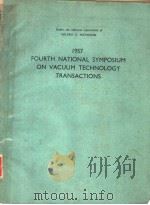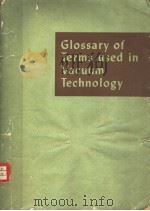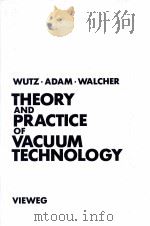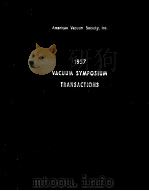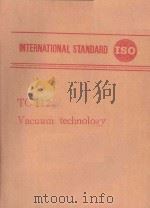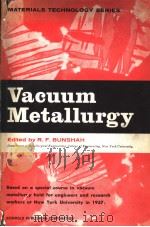《Vacuum Technology》
| 作者 | 编者 |
|---|---|
| 出版 | 未查询到或未知 |
| 参考页数 | 532 |
| 出版时间 | 没有确切时间的资料 目录预览 |
| ISBN号 | 无 — 求助条款 |
| PDF编号 | 811343778(仅供预览,未存储实际文件) |
| 求助格式 | 扫描PDF(若分多册发行,每次仅能受理1册) |

Chapter OneThe Nature of Vacuum1
1.1 What Is Vacuum?1
1.2 General Nature of a Gas1
1.3 The Atmosphere4
1.4 Units of Pressure7
1.5 Decimals and Powers of Ten9
1.6 Degrees of Vacuum11
1.7 Mean Free Path of a Gas11
1.8 Temperature Scales13
1.9 Effect of Pressure on a Gas15
1.10 Effect of Temperature on a Gas17
1.11 The General Gas Law19
1.12 Some Other Characteristics of Gases21
Chapter TwoVacuum Systems23
2.1 Elements of a Vacuum System23
2.2 Some Types of Vacuum Systems25
2.3 Quantity of Gas and Throughput26
2.4 Comparison with an Electric Circuit28
2.5 Comparison with Water Flow30
2.6 Resistances Connected in Series31
2.7 Resistances Connected in Parallel34
2.8 The Use of Logarithms36
2.9 Logarithmic Scales37
2.10 Pumping Speed41
2.11 Losses in Pumping Speed42
Chapter ThreeRotary Oil-Sealed Pumps49
3.1 The Nature of Such Pumps49
3.2 Pump Oils and the Oil System50
3.3 Ultimate Pressure52
3.4 Pumping Speed53
3.5 Effect of Connecting Lines56
3.6 Pump Size and Pump-Down Time—Method 162
3.7 Pump Size and Pump-Down Time—Method 265
3.8 Pump Size and Pump-Down Time—Method 367
3.9 Gas Handling Capacity of a Pump69
3.10 Some General Rules70
3.11 Setting Up Rotary Oil-Sealed Pumps70
3.12 Starting Rotary Oil-Sealed Pumps72
3.13 Stopping Rotary Oil-Sealed Pumps72
3.14 Maintenance Problems73
3.15 Use of a Nomograph76
Chapter FourVapor Pumps77
4.1 General Nature of Vapor Pumps77
4.2 Some Features of Diffusion Pumps79
4.3 Some Features of Ejector Pumps84
4.4 Mercury versus Oil87
4.5 Pump Performance89
4.6 Performance Characteristics of Diffusion Pumps92
4.7 Performance Characteristics of Ejector Pumps98
4.8 Migration of Pump Fluid98
4.9 Backing Pump Requirements100
4.10 Effect of Connecting Lines101
4.11 Pump-Down Time for Vapor Pumps103
4.12 Operating a Vapor Pump104
4.13Poor Operation or Failure of Vapor Pumps105
Chapter Five Some Other Types of Pumps109
5.1 Molecular Drag Pumps109
5.2 Roots Blower Pumps113
5.3 The Use of Getters as Pumps117
5.4 Gettering and Ionizing122
5.5 Pumps Using Evaporation and Ionization124
5.6 Pumps Using Sputtering and Ionization125
5.7 Cryopumping132
5.8 Other Sorption Pumps138
5.9 Water Aspirator,Toepler,and Sprengel Pumps139
Chapter SixMeasurement of Pressure142
6.1 The Nature of Vacuum Gauges142
6.2 Bourdon and Diaphragm Gauges143
6.3 U-Tube Manometers146
6.4 McLeod Gauges150
6.5 Pirani and Thermocouple Gauges162
6.6 Thermionic Ionization Gauges168
6.7 Cold Cathode Ionization Gauge176
6.8 Gauges Using Radioactive Materials181
6.9 Viscosity- and Radiometer-Type Gauges184
6.10 Use of Discharge Tube to Measure Pressure187
6.11 Gauges to Measure Very Low Pressures190
6.12 Calibration and Ranges of Vacuum Gauges193
Chapter SevenMeasurement of Pumping Speed198
7.1 Why Measure Pumping Speed?198
7.2 The Metered-Leak Method199
7.3 Positioning of Vacuum Gauge and Air Leak201
7.4 Admission of Air202
7.5 Vacuum Gauges205
7.6 Test Dome206
7.7 Rate-of-Rise Measurement207
7.8 Use of a Known Conductance211
Chapter EightProperties of Some Vacuum Materials216
8.1 The Elements216
8.2 Mercury and Water218
8.3 Liquids Used in Vacuum Practice219
8.4 Gases and Vapors222
8.5 Elastomers and Some Other Materials226
8.6 Glasses,Ceramics,and Metals Sealing to Them233
8.7 Copper and Copper Bearing Alloys236
8.8 Iron and Some of Its Alloys238
8.9 Molybdenum,Tantalum,and Tungsten240
8.10 Nickel and Its Alloys241
8.11 Vacuum Greases,Oils,Cements,and Waxes242
8.12 Some Drying and General Sorption Agents249
8.13 Temperature Data252
8.14 Alphabetical Listing252
Chapter NineCleaning Techniques262
9.1 The Nature of Contaminants262
9.2 General Methods of Reducing Contamination263
9.3 Descaling and Pickling Processes266
9.4 Electrolytic Cleaning and Polishing268
9.5 Cleaning of Mercury and Glass271
9.6 Miscellaneous Cleaning Procedures273
9.7 Cleaning by Degassing274
Chapter TenSome Fabrication Techniques279
10.1 Glass versus Metal279
10.2 Glass-to-Metal Seals281
10.3 Fabrication of Some Other Types of Seals283
10.4 Soldering285
10.5 Brazing288
10.6 Hydrogen Brazing298
10.7 Welding301
10.8 Electroplating305
10.9 Gasketed Joints309
10.10 Construction of Vacuum Vessels318
Chapter Eleven Baffles,Traps,and Valves322
11.1 The Use of Baffles and Traps322
11.2 Some Designs of Baffles324
11.3 Some Designs of Traps328
11.4 Operation and Maintenance of Baffles and Traps338
11.5 Liquid Nitrogen Filling Systems341
11.6 Pumping Losses in Baffles and Traps343
11.7 The Functions of Vacuum Valves349
11.8 Gate,Disk,and Flap Valves351
11.9 Globe,Needle,and Diaphragm Valves356
11.10 Stopcock,Plug,and Ball Valves359
11.11 Bakable Valves363
11.12 Some Special Valves367
11.13 Care and Maintenance of Valves369
Chapter TwelveSome Other Vacuum Components371
12.1 Common Static Seals Using Elastomers371
12.2 Sliding and Rotating Seals377
12.3 High Temperature Seals383
12.4 Low Temperature Seals388
12.5 Some Other Forms of Seals391
12.6 Couplings,Hose Clamps,etc.395
12.7 Electrical Lead-Throughs398
12.8 Leak Devices and Cut-Offs401
12.9 Protective Devices407
Chapter ThirteenConventional Vacuum Systems411
13.1 The Nature of Such Systems411
13.2 Basic Design Considerations412
13.3 Conductances of Components413
13.4 Designing a Vacuum System414
13.5 Setting Up a New Vacuum System422
13.6 Starting Up a Vacuum System423
13.7 Starting and Operating Tight Vacuum Systems426
13.8 Shutting Down a Vacuum System428
13.9 Maintenance Problems with Vacuum Systems429
13.10 The Small Vacuum Laboratory430
Chapter FourteenVery High and Ultra-High Vacuum Systems433
14.1 The Nature of Such Systems433
14.2 Small Very High Vacuum Systems434
14.3 Small Ultra-High Vacuum Systems436
14.4 Bake-Out Arrangement for Small Systems440
14.5 Bake-Out Procedure for Small Systems441
14.6 Large Low Pressure Vacuum Systems444
14.7 Bake-Out of Large Systems451
14.8 Construction Materials and Techniques453
14.9 Is There a Low Pressure Limit?454
Chapter FifteenFinding and Repairing Leaks456
15.1 When Is a System Tight?456
15.2 Sizes of Leaks457
15.3 Methods of Leak Detection458
15.4 Sealing Substance Outside,Pressure Change Inside460
15.5 Rate-of-Rise Measurements460
15.6 High Pressure Inside,Indicator Outside463
15.7 Spark Coils and Discharge Tubes466
15.8 Probe Materials with Standard Vacuum Gauges468
15.9 Unique Response of Vacuum Gauges469
15.10 Halogen Leak Detectors473
15.11 The Helium Leak Detector474
15.12 Sensitivity of Helium Leak Detectors475
15.13 Response and Clean-Up Times478
15.14 Vacuum Testing480
15.15 Pressure and Pressure-Vacuum Testing484
15.16 Commercial Helium Leak Detectors488
15.17 What Leak Detection System Should Be Used?493
15.18 Some General Rules for Leak Hunting497
15.19 Repairing Leaks499
Appendices503
AQuantities from Kinetic Theory of Gases503
B Mechanical,Ejector,and Diffusion-Ejector Pump Oils506
C Quantities and Relationships Useful in Vacuum Practice508
D Appearance of Discharges in Gases and Vapors at Low Pressures514
E Bibliography515
Index523
《Vacuum Technology》由于是年代较久的资料都绝版了,几乎不可能购买到实物。如果大家为了学习确实需要,可向博主求助其电子版PDF文件。对合法合规的求助,我会当即受理并将下载地址发送给你。
高度相关资料
-

- 1956 NATIONAL SYMPOSIUM ON VACUUM TECHNOLOGY TRANSACTIONS
- 1957 PERGAMON PRESS
-

- ADVANCES IN VACUUM SCIENCE AND TECHNOLOGY VOLUME I
- 1960 PERGAMON PRESS
-
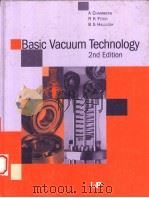
- BASIC VACUUM TECHNOLOGY SECOND EDITION
- 1998 IOP PUBLISHING LTD
-

- VACUUM TECHNOLOGY
- 1963 CHAPMAN & HALL LTD.
-
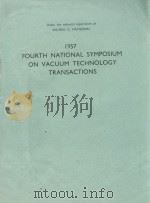
- 1957 FOURTH NATIONAL SYMPOSIUM ON VACUUM TECHNOLOGY TRANSACTIONS
- 1958 PERGAMON PRESS
-
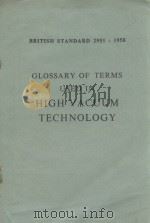
- GLOSSARY OF TERMS USED IN HIGH VACUUM TECHNOLOGY
- 1958 BRITISH STANDARDS INSTITUTION
-

- 1959 SIXTH NATIONAL SYMPOSIUM ON VACUUM TECHNOLOGY TRANSACTIONS
- 1960 PERGAMON PRESS
-
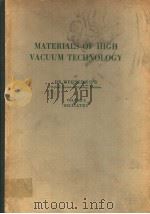
- MATERIALS OF HIGH VACUUM TECHNOLOGY VOLUME 2 SILICATES
- PERGAMON PRESS
提示:百度云已更名为百度网盘(百度盘),天翼云盘、微盘下载地址……暂未提供。➥ PDF文字可复制化或转WORD
